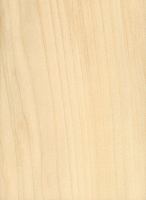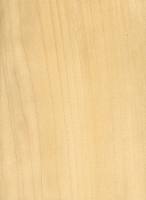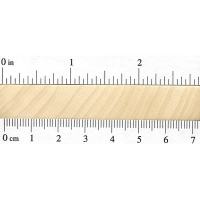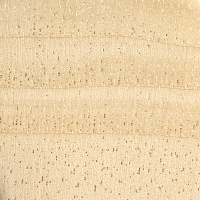 |
Common Name(s): Water Tupelo, Tupelo-gum Scientific Name: Nyssa aquatica Distribution: Southeastern United States Tree Size: 65-100 ft (20-30 m) tall, 2-3 ft (.6-1.0 m) trunk diameter Average Dried Weight: 34 lbs/ft3 (550 kg/m3) Specific Gravity (Basic, 12% MC): .46, .55 Janka Hardness: 870 lbf (3,870 N) Modulus of Rupture: 9,650 lbf/in2 (66.5 MPa) Elastic Modulus: 1,250,000 lbf/in2 (8.62 GPa) Crushing Strength: 5,910 lbf/in2 (40.8 MPa) Shrinkage: Radial: 4.2%, Tangential: 7.6%, Volumetric: 12.5%, T/R Ratio: 1.8 |
Color/Appearance: Sapwood is very wide, and is generally a pale yellow color, sometimes with a grayish cast. Heartwood is narrower, and is a medium brown to gray. Quartersawn surfaces exhibit ribbon-stripe patterning due to interlocked grain.
Grain/Texture: Grain is interlocked, with a fine texture.
Endgrain: Diffuse-porous; radial multiples of two to four pores; small to medium pores arranged in a radial pattern, numerous; parenchyma not visible with lens; narrow rays, spacing fairly close.
Rot Resistance: Rated as non-durable to perishable; also susceptible to insect attack.
Workability: Easily worked with hand or machine tools, though tupelo has a tendency to warp while drying, and has a high amount of movement in service. Responds well to power-carving, with little fuzz-up.
Odor: No characteristic odor.
Allergies/Toxicity: Besides the standard health risks associated with any type of wood dust, no further health reactions have been associated with Water Tupelo. See the articles Wood Allergies and Toxicity and Wood Dust Safety for more information.
Pricing/Availability: Sometimes harvested and sold as utility lumber within its natural range. Tupelo is also occasionally available as larger carving blocks. Lumber prices should be moderate for a domestic hardwood, though carving blocks can be rather expensive depending on the size and quality.
Sustainability: This wood species is not listed in the CITES Appendices or on the IUCN Red List of Threatened Species.
Common Uses: Carving, furniture, crates/boxes, and utility wood.
Comments: The name tupelo is of Native American origin, coming from the Muskogee words ito (tree) and opilwa (swamp). Water Tupelo trees have tapered trunks that swell out to a larger base, giving it stability in wet soils and swamps. This swollen base lends itself well to harvesting for carving blanks.
Tupelo is a favored wood for wildfowl carvings. It generally is able to take finer details, holds paint better, and does not fuzz up during power carving like Basswood.
None available.







